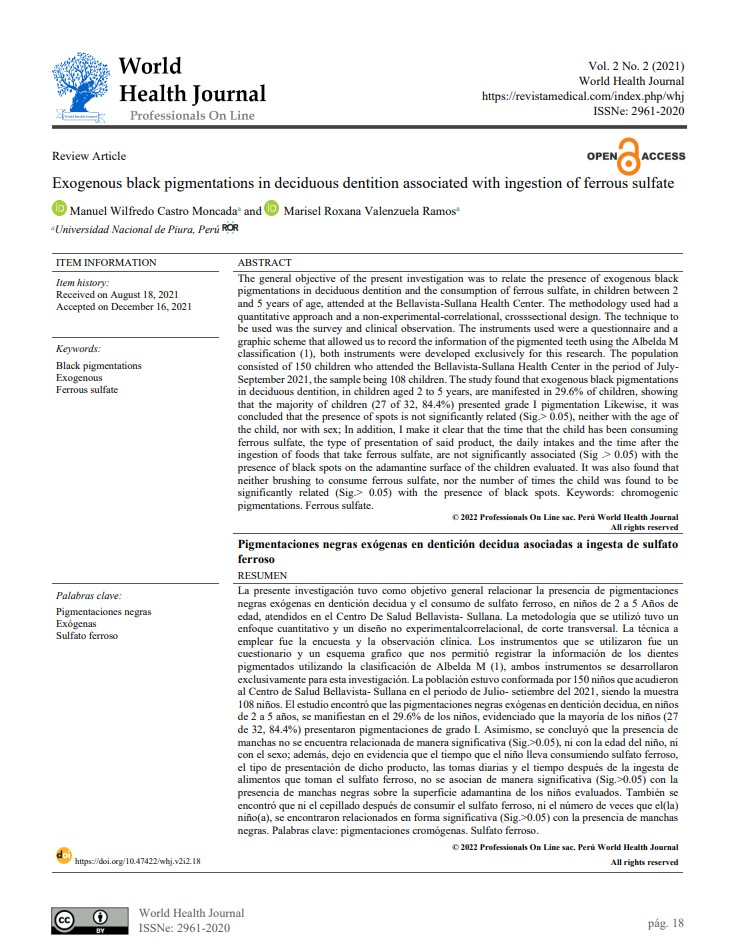Abstract
The general objective of the present investigation was to relate the presence of exogenous black pigmentations in deciduous dentition and the consumption of ferrous sulfate, in children between 2 and 5 years of age, attended at the Bellavista-Sullana Health Center. The methodology used had a quantitative approach and a non-experimental-correlational, crosssectional design. The technique to be used was the survey and clinical observation. The instruments used were a questionnaire and a graphic scheme that allowed us to record the information of the pigmented teeth using the Albelda M classification (1), both instruments were developed exclusively for this research. The population consisted of 150 children who attended the Bellavista-Sullana Health Center in the period of July-September 2021, the sample being 108 children. The study found that exogenous black pigmentations in deciduous dentition, in children aged 2 to 5 years, are manifested in 29.6% of children, showing that the majority of children (27 of 32, 84.4%) presented grade I pigmentation Likewise, it was concluded that the presence of spots is not significantly related (Sig.> 0.05), neither with the age of the child, nor with sex; In addition, I make it clear that the time that the child has been consuming ferrous sulfate, the type of presentation of said product, the daily intakes and the time after the ingestion of foods that take ferrous sulfate, are not significantly associated (Sig .> 0.05) with the presence of black spots on the adamantine surface of the children evaluated. It was also found that neither brushing to consume ferrous sulfate, nor the number of times the child was found to be significantly related (Sig.> 0.05) with the presence of black spots. Keywords: chromogenic pigmentations. Ferrous sulfate.
References
DeLoughery TG. Iron Deficiency Anemia. Med Clin North Am. marzo de 2017;101(2):319-32.
Short MW, Domagalski JE. Iron deficiency anemia: evaluation and management. Am Fam Physician. 15 de enero de 2013;87(2):98-104.
Subramaniam G, Girish M. Iron deficiency anemia in children. Indian J Pediatr. junio de 2015;82(6):558-64.
Bernardo A, Amparo M. Estudio de la aplicación de la terapia fotodinámica sobre las pigmentaciones extrínsecas negras de origen bacteriano. 19 de diciembre de 2016 [citado 4 de noviembre de 2016]; Disponible en: https://repositorioinstitucional.ceu.es/handle/10637/8402
Henríquez Alas LA, Berciano Castillo MB, Martínez Orellana DA. Prevalencia de pigmentaciones exógenas en dentición primaria por ingesta de suplementos férricos en los municipios de: Guaymango, Citalá y Guacotecti. [Internet] [bachelor]. Universidad de El Salvador; 2015 [citado 4 de noviembre de 2017]. Disponible en: https://ri.ues.edu.sv/id/eprint/13055/
Yarlequé Andrade ST. Evaluación in vitro del grado de adsorción de sulfato ferroso en dientes de bovino a diferentes tiempos de exposición. Univ César Vallejo [Internet]. 2017 [citado 4 de noviembre de 2017]; Disponible en: https://repositorio.ucv.edu.pe/handle/20.500.12692/741

This work is licensed under a Creative Commons Attribution 4.0 International License.
Copyright (c) 2021 Manuel Wilfredo Castro Moncada, Marisel Roxana Valenzuela Ramos

